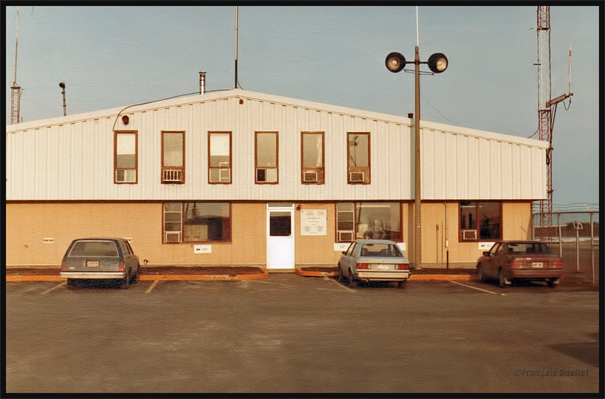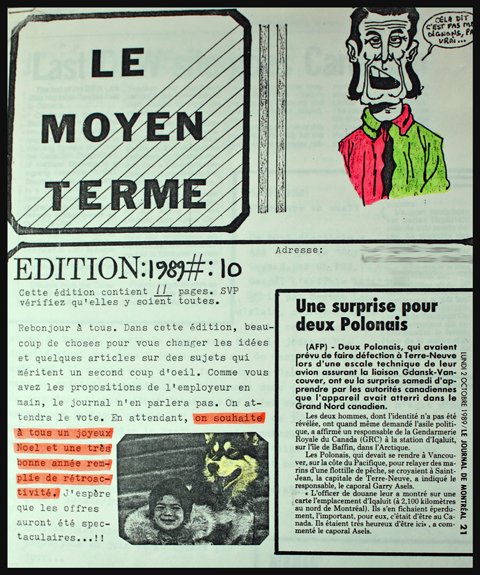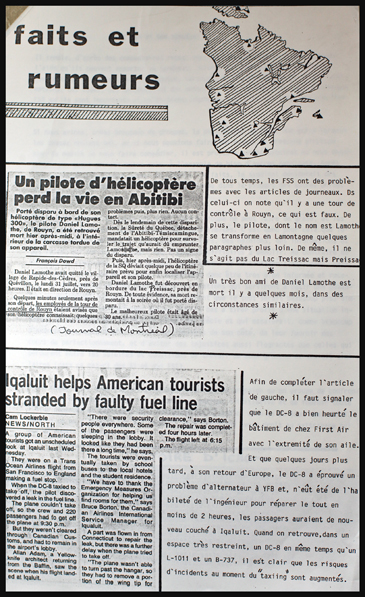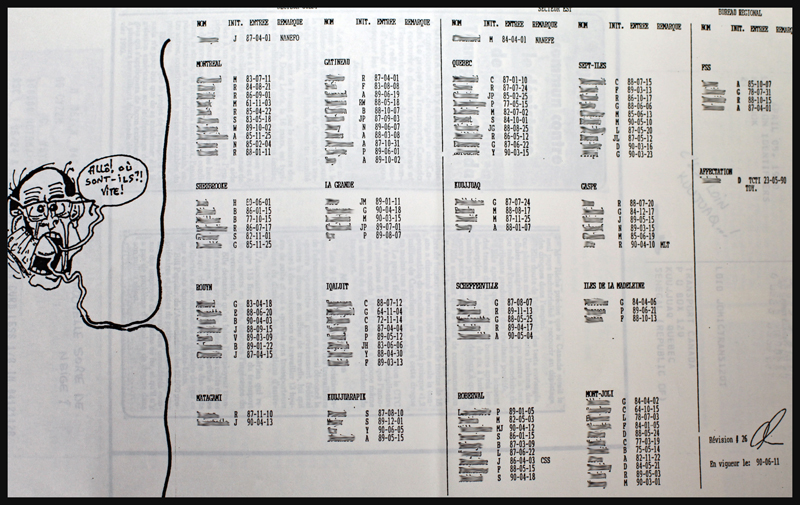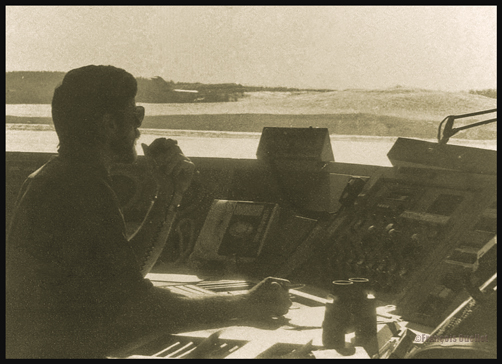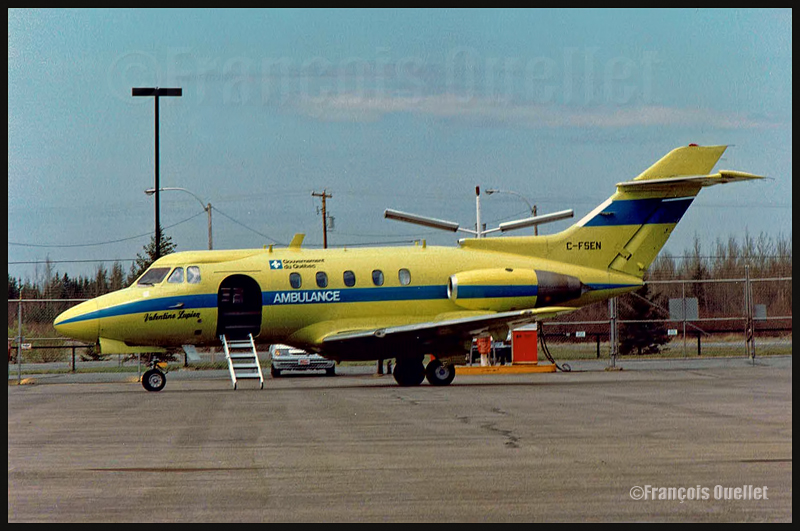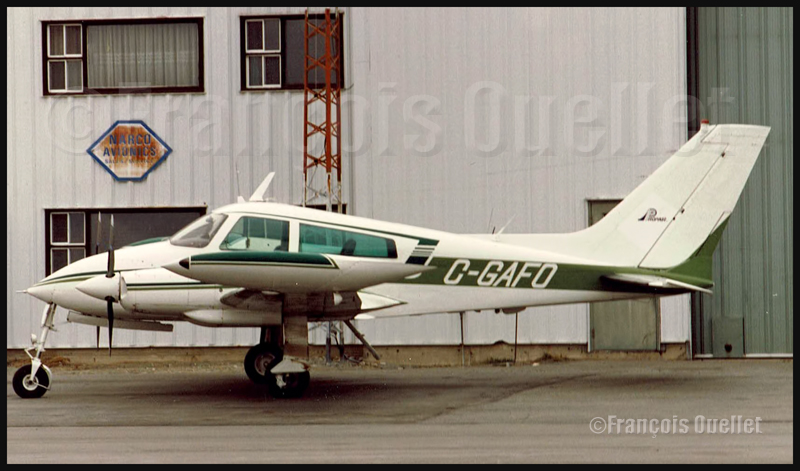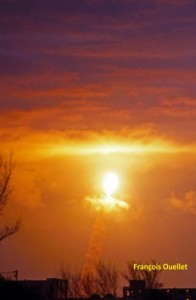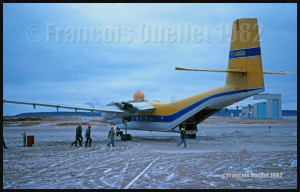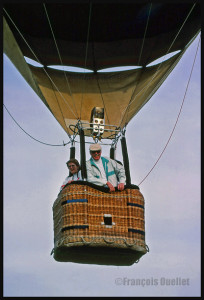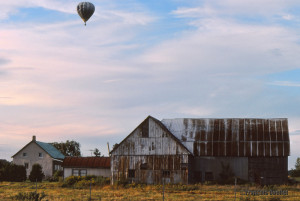Enroute for the second posting: Rouyn-Noranda FSS
November 1983. After having worked every day for more than a year, it was time to leave Inukjuak for a new flight service station located in Rouyn-Noranda. Things got complicated on the day of departure, the weather worsening rapidly. An Air Creebec Twin Otter from Kuujuaraapik would now do the flight. But this company’s route implied numerous stopovers along James Bay.
With the strong winds and low clouds, I was aware that we would be in for a rough ride. The clouds being merely few hundred feet above the tree tops, the pilots had to do the whole flight and the multiple stopovers while dealing with those limitations. Along the route, there was no airport equipped to allow instrument landings. The runways were short, in gravel or dirt, and trees sometimes near the thresholds forced the pilots to adopt steeper rate of ascent or descent.
After few hours of flying in this sustained mechanical turbulence, many passengers started to experiment air sickness. They had to use the practical little bag offered by all the companies. I changed my mind by looking through the window. There was no choice of music for the flight: the wheezing and grunting noises of the passengers were used as background ambiance.
We finally landed in Val-d’Or late in the evening. It was different to see a long asphalted runway and an airport equipped with appropriate instruments. One hour later, I was in Rouyn-Noranda. Welcome in the South…!
The newspaper “Le Moyen Terme”
Since the Quebec flight service stations were disseminated over a vast territory, the communications between the employees of each station were quite limited. It was difficult to obtain relevant information on staff transfers: such information was badly needed when came the time to choose the next transfer site.
How would an employee be able to insist that there is availability in Montreal if he did not have in front of him, during the “discussion”, such verified information? To correct the situation, once I was working at Rouyn-Noranda FSS, I decided to create my own newspaper, titled “Le Moyen Terme”.
The newspaper was distributed to every Quebec flight service stations, to the Transport Canada Training Institute in Cornwall, to Montreal regional office and to Ottawa headquarters. Suddenly, the Quebec flight service specialists were having access to relevant information that was updated on a regular basis.
I had contributors from all over the province, and as the newspaper gained in credibility, even Ottawa managers started to provide me with some input. I financed the newspaper, wrote most of the articles and mailed a new edition every two months. I was indebted to nobody. This did not preclude the reception of a lawyer’s letter, but in such a controlled environment, that did not come as a surprise. I presented the letter to a well-known judge who took care of the matter for free. He closed the case in one swift move.
Each edition had ten to fifteen pages. It was typed using an old typewriter and mistakes were erased using correcting fluid. A small part of the content was meant to amuse the reader, but must of the information was of an editorial nature. The texts were generally received positively by the employees and that contributed to a regular exchange.
The section that was possibly the least appreciated by the regional office was titled: “Where are they?” On that page, one could find the name of every employee working at a particular station, with its seniority. The details were now readily available to everybody. The information provided by the management could now be crosschecked by the staff. This possibly annoyed some managers who, until recently, had a relatively easy task in attributing respective postings.
One day, I had to visit the Montreal regional office. A high ranking manager, aware of my visit, invited me in his office and ordered me to stop the production of the newspaper. I told him that it was out of question and that the newspaper was useful to many employees. My answer, at the time, did not make me friends in high places, but it was not my goal. The newspaper was produced for another two years. I decided to end this personal project when I had no more time to take care of it, busy with multiple university courses and a seven days a week working schedule in Iqaluit. Since I did not want to dilute or diminish the content or the quality of the newspaper I had created, I chose to stop its production.
(Note: the comic-book characters were created by Gotlib)
The Cessna 172 that was pulling a 100 kilos cement block
On a nice summer day of July, at the Rouyn-Noranda airport, a pilot from a local flying club called our flight service station to get the latest airport advisory for a takeoff. He wanted to use a Cessna 172. He got the details and started taxiing. I quickly noticed that the aircraft was pulling an object. Using the binoculars, I could see that it was a cement block of about 100 kilos, attached to a rope. That cement block was normally used to immobilize an aircraft after a flight.
It was now obvious that the pilot had not done his walk around the aircraft, a mandatory procedure to ensure that everything is normal. Pulling that cement block on the asphalt must have required more power from the engine. I asked the pilot: “Don’t you find that more power is required to taxi today?” He answered that, in fact, he noted the need to increase the engine’s revolutions and that it was possibly due to the outside high temperature and moisture.
Without further delays, I replied: “Did you walk around your aircraft before the flight to make sure that everything was OK?” At that very moment, he understood that something needed to be done. He stopped the aircraft on the taxiway, got out and realized why a higher RPM was needed to taxi. Without saying anything that could imply his personal negligence, since he knew the radio communications were recorded, he announced that he was returning to the flying club. He had “forgotten something”…
The working position of the old Rouyn-Noranda flight service station allowed only a partial view of runway 08/26, but a complete view of the taxiway where the Cessna 172 was pulling its cement block.
Fictive official procedures
During the eighties, while I was working at the Rouyn-Noranda FSS, I received a phone call from a Val-d’Or air traffic controller. He told me that there was a problem with the type K ARCAL. The ARCAL allows a pilot to remotely activate the runway lights.
Normally, the pilot can choose between three intensities: low, medium and high. But it now seemed that for an extended period, the ARCAL’s low intensity would not be serviceable. The controller told me to issue a NOTAM stating that nobody could use the ARCAL for an indefinite period.
I did not agree with that request. An ARCAL system that was left available would facilitate a pilot’s life by allowing him to choose between the remaining intensities during the approach, or on takeoff. The pilots of the Quebec Government HS125 in charge of medical evacuations during night time would certainly appreciate.
I told the controller that I did not know of any approved procedures relating to an ARCAL type K system failure and that I did not see why I would consider totally unserviceable a system in which only one intensity out of three was posing a problem.
He replied that those were the written procedures that could be found in the control tower and that I had to call his manager if I wanted to see them. How was it possible that official procedures pertinent to a system installed on many airports across Canada, with or without a control tower, could only be found in selected control towers? This was unthinkable.
Through my manager, I asked to receive a copy of those procedures. But it now seemed that those procedures were not in the Val-d’Or control tower but in the Montreal regional office. I tried to get them from that office, but nobody could find anything on the subject.
It was now obvious that those procedures never existed. The funny thing is that all the stakeholders were defending, one level at a time, the existence of those fictive procedures, for all kind of reasons.
During those years, there was a program called “Incentive Award”, encouraging an employee to present new ideas that would improve the efficiency of the public service. If a proposition was accepted by the highest management levels, a certificate accompanied with a small amount of money would be sent to the employee by the Deputy Minister at Transport Canada. Realizing I would not obtain satisfaction from the regional management, I used the “Incentive Award” program to present my proposition.
One year later, I received a call from somebody who told me he was working at the national level, in Ottawa. He implied that my suggestion would not be accepted.
I told him that I paid, like other Canadians, to get the ARCAL system installed and that, as long as one intensity would remain serviceable, the ARCAL would have to be available to pilots. I made sure he understood that I could not care if he felt comfortable with the idea or not. He was advised that if he maintained his view on the subject, he would have to justify his action to the Canadian public and to the Minister of Transport, who, at the time, was Benoît Bouchard.
Two months later, I received a check and a letter from the Deputy Minister of Transport Canada thanking me for my suggestion that was improving the efficiency of public service. Fourteen months were needed to make the transition from fictive to official procedures that now apply to all Canadian airports equipped with this type of remote control of runway lights.
A twin-engine plane avoids a standing fisherman in his boat
During the summer season, air surveillance is needed to watch for new forest fires in the center and north of the Quebec Province. There are periods, sometimes many days in a row, where the pilots do not observe anything significant. They accumulate hours of flying, quietly waiting to see a new fire or expecting to be directed by a dispatcher to a new problematic area. Those pilots also act as spotters for the Canadair CL215’s and CL415’s.
During the eighties, in the Abitibi region, a Cessna 310 had been in flight for few hours and the pilot had not spotted anything worth a call. Wishing to add a bit of action to his flight, he decided to descend and follow the meanders of a river at an extremely low altitude. As he exited a bend, the pilot faced a standing fisherman in its boat, angling in open water. Imitating the gestures of the fisherman, the pilot said that he was not the only one to be surprised…
It might be hard to believe that an aircraft could fly that low, especially when exiting a bend in a river. But after many decades in the aviation world, I can say that almost everything is possible. I imagine the fisherman’s reaction, quietly angling during a beautiful summer morning. While the fisherman lowers his head, the pilot pulls on the controls…
The expression in the pilot’s face showed clearly that he had had enough action for the day…I would like to swear that it was his last daring move, but it would be to ignore that this need for extreme flying is always present in some pilots.
Pilots: from best to worst
October 1984. It was time for the annual holidays. Florida was the destination. What made the trip more interesting was that the Challenger space shuttle would be launched while we would be there, and that the Canadian astronaut Marc Garneau would be on board. He was the first Canadian astronaut have to opportunity to go in space.
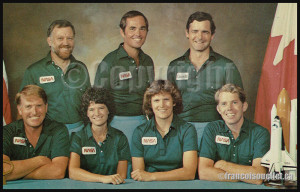
The plane’s tickets were bought and one morning of the whole trip was reserved for the shuttle’s takeoff. I was planning to take a picture of the launch from Cocoa Beach. The shuttle would be airborne before daylight, while it was still quite dark.
I had a very basic camera at the time and all the settings had to be done manually. The aperture and speed were adjusted to ensure a well-balanced picture. But I never expected that the gas combustion would illuminate the sky in such a radical way. I believed, like many people, that the thundering noise from the engines would be the first sign that the launch had just happened.
But the speed of light being way faster that the speed of sound, we suddenly experienced a radical change in the ambient light. I had barely enough time to modify the settings before the shuttle entered the clouds. But I still managed to bring back a little souvenir from that day…
I had just seen something spectacular. I knew that on board were pilots with exceptional talent.
But two months before, while I was working at Rouyn-Noranda FSS, I witnessed a different kind of performance. One day that I was listening to a frequency that is not normally used for communications between pilots and air traffic service, I heard two pilots exchange the questions and answers found on some airline pilot license written exams. The pilot’s comments gave me the feeling that they would be very lucky to succeed at such written exam.
I took the microphone and, without announcing myself, intervened as a third party in the discussion. I asked them to repeat the questions and answers that they just gave each other because I did not have time to copy everything.
The pilots were stunned to realize that other people were listening while they were exchanging the data on the air. One of them said: “Did you hear that?” They immediately ended the communication. The simple fact of using radio frequencies for such activities told a lot about the quality of their judgment. And judgment is an essential quality of every performing pilot…
Propair, Caribous (DHC-4) and the Irangate
In 1986, the Propair Company’s hangar was located very close from our flight service station in Rouyn-Noranda. There were frequent exchanges between their staff and our FSS’s. One day, one of their employees told us that two American pilots had just come to the airport to take delivery of a Caribou DHC-4 cargo aircraft that had been sold by Propair.
The aircraft would be exported. The DHC-4 is known to be a very practical aircraft as it can carry heavy loads and manage to takeoff or land on an extremely short distance.The pilots took-off with their used Caribou and we did not hear any more from them until the world Medias started to talk about the Irangate affair. I can talk about it today as it is a public affair: details can be found on the internet.
The Rouyn-Noranda Propair Company had in fact sold not one but two used DHC-4 Caribous to a consultant working for a panamean company. One of the DHC-4 was later registered in El Salvador. One of the two Caribous experienced an engine failure over the mountains, enroute towards El Salvador. In order to stay in the air, and considering the extreme outside moisture and air temperature, the crew had no other choice than to get rid of some weight. Spare parts in the cargo bay, including a brand new engine still in its crate, were pushed outside the plane, falling in the jungle below. But the plane had eventually no other choice than to land before arriving to its initially planned destination, Ilopango.
All this was linked to the Contras who were engaged in warfare operations against the Nicaraguan leftist government of Daniel Ortega. In order to finance the covert operations, a secret budget was necessary: some Americans were selling arms to Iran, even if there was an official ban, and the money received was financing warfare operations. A journalist who had followed this story closely and made important discoveries was found dead. He had apparently committed suicide by shooting himself twice in the head…
One of the pilots who departed Rouyn-Noranda with a DHC-4 was named Sawyer. This man would later fly, undercover operations organized by the CIA, a C123 cargo type aircraft that was shot down in southern Nicaragua. The pilot and co-pilot were killed but a passenger, Eugene Hasenfus, parachuted out knowing the aircraft would soon crash. He was interrogated and revealed the details that allowed the discovery of the secret deal with Iran.
The Oliver North’s testimony in front of the Congress kept that story alive for a long time. Eventually, like everything, this story was progressively forgotten. Thirty years later, I still remember the numerous phone calls that the flight service station received from the Medias about this affair.
A book published in 2013 and titled “Raymond Boulanger, le pilote mercenaire” adds several details to this story, since Mr Boulanger was himself a pilot hired by the CIA.
A squall line goes through the Rouyn-Noranda airport
1986. It was a beautiful summer afternoon at the Rouyn-Noranda airport. The flight service station staff knew that a cold front was approaching and would soon sweep the airport. Until then, it was still a perfect day. Blue sky, light winds. At the time, flight service specialists did not have access to radar images or satellite pictures.
To get an idea of what was coming from the west, we were normally using an Environment Canada aviation weather forecast and the actual weather observations of two flight service stations in Ontario, Earlton FSS and Timmins FSS. Their last weather observation mentioned a wind shift and an isolated thunderstorm. But Timmins was far away and could only provide us with a rough estimate of the situation.
As I was working the evening shift on that day, I checked the wind speed indicator, as a reflex developed throughout the years. What I saw was kind of unreal. The speed indicator’s needle suddenly went from showing few knots to 20 knots, and then 40 knots, hesitated a little then went up to 60 knots and, in a final correction, reached 72 knots, which was about 134 km/h.
Everything was so peaceful around the flight service station. I looked through the window to detect any moving object. At that very moment, the wooden shed normally used by the fuel man passed in front of the station. That wooden structure must certainly have weighted few hundred kilos. The fact that it was moving at a good speed was a clear indication that the instruments were working properly. A squall line was associated with the cold front progression.
Everything that was not properly fixed to the ground started moving. In the next hour, strong thunderstorms going eastward moved in over Rouyn-Noranda. The Val-d’Or airport being located sixty miles east, it was clear that it would be hit directly in about two hours. I called the Val-d’Or control tower so that everyone got prepared for the squall line. That gave them enough time to tie everything correctly and damages were limited.
One hour later, everything was back to normal in Rouyn-Noranda and we profited from an ideal summer night.
A wedding anniversary in a hot air balloon (C-GFCM)
Summer 1988. I only had few months left at the Rouyn-Noranda flight service station before being transferred to Iqaluit, an isolated nordic post near the arctic circle. That summer, during my annual holidays, I took few days to drive to St-Jean-sur-Richelieu, just in time for my parent’s wedding anniversary.
We thought of offering them a ride in a hot air balloon. The balloon would lift from a field facing the St-Jean-sur-Richelieu Cégep.
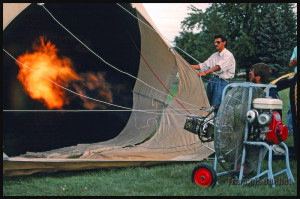
The winds were favoring a flight path that would allow the crossing of the Richelieu River. The pilot would profit from that opportunity since the crossing of that river is very popular with the city’s inhabitants. We just hoped that the wind direction would not change while the balloon was over the water.
The amount of propane gas being limited, the flight would have to be at a quick enough pace to allow the pilot to get away from Iberville’s buildings once on the other side of the river. I don’t think my parents were worried about those details. I imagined that their anxiety was instead building up at the same time as the balloon envelope was gaining volume.
As soon as the balloon lifted off, it drifted towards the river. This would allow the pilot to touch the river with the basket, something he did twenty minutes later with great ability.
The balloon then regained altitude, just high enough to skim over a corn field on the other side of the river. We were following the balloon’s path by car. We used all the shortcuts available, and were creative when it came to following traffic rules and road signs.
About one hour later, the pilot started the descent. The balloon landed without problem in a field. When essential manoeuvers were completed, he surprised us by pulling few items out of the basket: a small folding table, a red-checked tablecloth and glasses for everyone.
The evening was a complete success. Somewhere in the countryside, just before night time, we celebrated with a bottle of champagne…
Aviation photography: Rouyn-Noranda aircraft photos between 1986-1988 (part 1 of 3)
Here are few aircraft photos taken at the Rouyn-Noranda airport during the 1986-1988 period, while I was working as a flight service specialist (FSS). Those are not fancy pictures but they nonetheless provide a representative sample of what was flying over the Abitibi region during those years. As such, they are part of the Quebec Province aviation history. It is possible that you might see some of the company names or colours for the first time.
I took these photos with an old Pentax KX, using Kodachrome film. I intend to publish the three series over the next few weeks. Many types and categories of aircrafts will be included: private, commercial, corporate, governmental, military, etc. I am convinced that some pictures will bring back memories to older pilots.
In this first part, you will find the following: Tim Hortons AC6T, Sunwest Lear 35 C-GVVA, Québec Aviation SW4 C-GQAP, Propair DHC-3 C-FOOH, Government of Québec HS-125 C-FSEN, Trans North Air helicopter Bell 47G3B2 C-FQJY, Government of Québec DC-3, Conquest Flight Group C-411 N88727, Cité Express DHC-7 C-GHRV, Government of Canada CL-601 C-GCFI, Manitoulin Air Service C185F C-GTLO, Central Airways BE-20 C-FANG, Canadian Pacific B737-200 C-FCIP, Bellanca Scout C-GPKB, Aérospatiale Écureuil AS-350, Austin Airways BAE-748 C-GGOO, Viking AS-350 C-GBPS, Air Dorval SW2, Air Canada B-727, Aero-Commander C-GOTL.
Aviation photography: Rouyn-Noranda aircraft photos between 1986-1988 (part 2 of 3)
Here is the second group of aircraft photos taken at the Rouyn-Noranda airport during 1986-1988, while I was working as a flight service specialist (FSS). Those are not fancy pictures but they nonetheless provide a representative sample of what was flying over the Abitibi region during those years. As such, they are part of the Quebec Province aviation history. You have possibly discovered some company names and colours already in part 1 of 3, published on June 29th 2015.
I took those photos with an old Pentax KX, using Kodachrome film. Many types and categories of aircrafts and helicopters are included: private, commercial, corporate, government, etc. I am convinced that some pictures will bring back memories to older pilots.
In this second part, you will find the following: Ailes de Charlevoix Commander 500S C-GAYR, Propair C-310 C-GAFO, Voyageur Airways BE-10 C-GISH, Skycharter FA-20 C-GSKQ, SEBJ Convair 580, Québecair SA226-TC-MetroII C-GKFS, Nordair-Metro CV-580, Noranda Mines Gulfstream 1 C-FNOR, Government of Canada Challenger 601 for VIP, Cessna C-150 C-FRGC, Canadian Pacific B737-200 C-GNDM, Government of Québec FA-27 C-FPQI, Government of Canada GRC C-208 Caravan 1 C-FMPB, Normick-Perron helicopter Bell 206B C-GAKN, Beech Sierra BE-24 C-FZYD, Astar 350 Écureuil and Dighem, Air Dorval Westwind, Air Charters PA-31 C-GBMX, Air Canada DC-9.
Aviation photography: Rouyn-Noranda aircraft photos between 1986-1988 (part 3 of 3)
Here is the third group of aircraft photos taken at the Rouyn-Noranda airport during 1986-1988, while I was working as a flight service specialist (FSS). Those are not fancy pictures but they nonetheless provide a representative sample of what was flying over the Abitibi region during those years. As such, they are part of the Quebec Province aviation history. You have possibly discovered some company names and colours already in the last two aviation photography documents published on June 29th and July 11 th 2015.
I took those photos with an old Pentax KX, using Kodachrome film. Many types and categories of aircrafts and helicopters are included: private, commercial, corporate, government, etc. I am convinced that some pictures will bring back memories to older pilots.
In this third and final group of photos, you will find: Québecair Convair, Noranda Mines Lear 25 C-GZIM, Propair Hugues 500D C-GDFF, Mitsubishi MU-2 C-GAUR, Transport Canada DHC-8-102 C-GCFJ, Government of Canada CP-140 Aurora, Cessna C-425 Conquest 1 C-GLAD, Hugues 300 C-GBUM, Cessna C-210 C-GVYD, Inter-Canadien Fokker F-28-1000 C-GQBR, Viking Bell 212 C-GFQN, Air Creebec C-402, Hélico Mont-Laurier Enstrom C-GNUZ, Kelner Airways C028B Caravan 1 C-FKAL, Cessna C-172 C-GUCU, Nordic Bell 206l C-FARV, Cessna C-172 C-FBOI, Cessna C-175 C-FKVE, Scout Chief C-FXGS, Noranda Mines Beech 300 C-GPKP, Québec Aviation Commander 840 C-GPVE, Piper PA-32-300 C-GBRZ, Piper Cherokee 140E C-FTVV.

